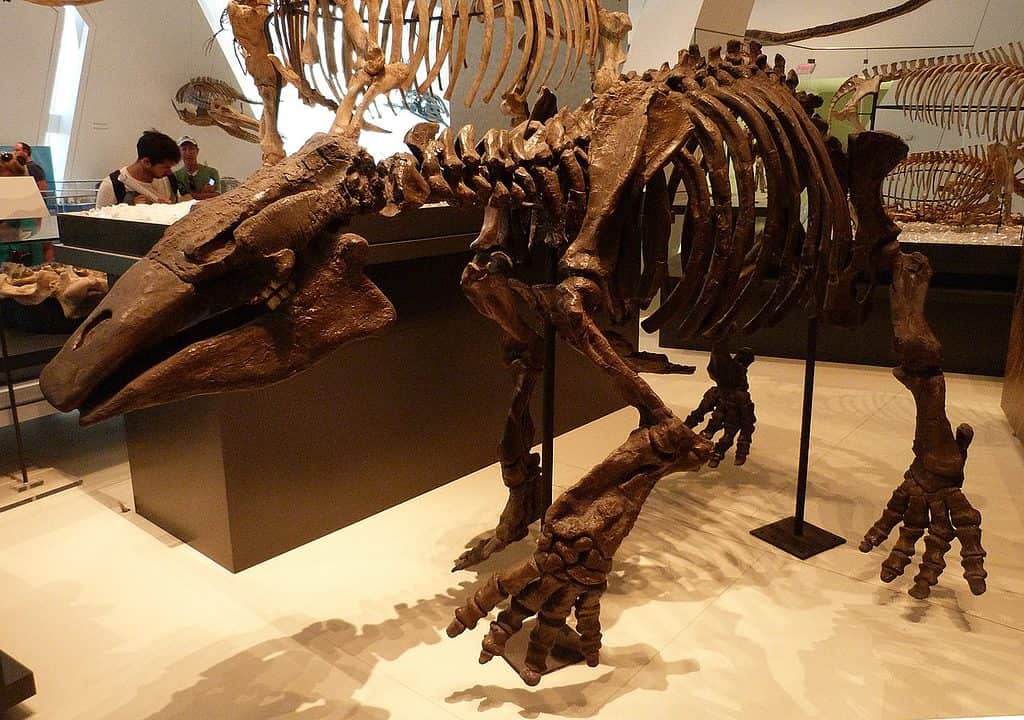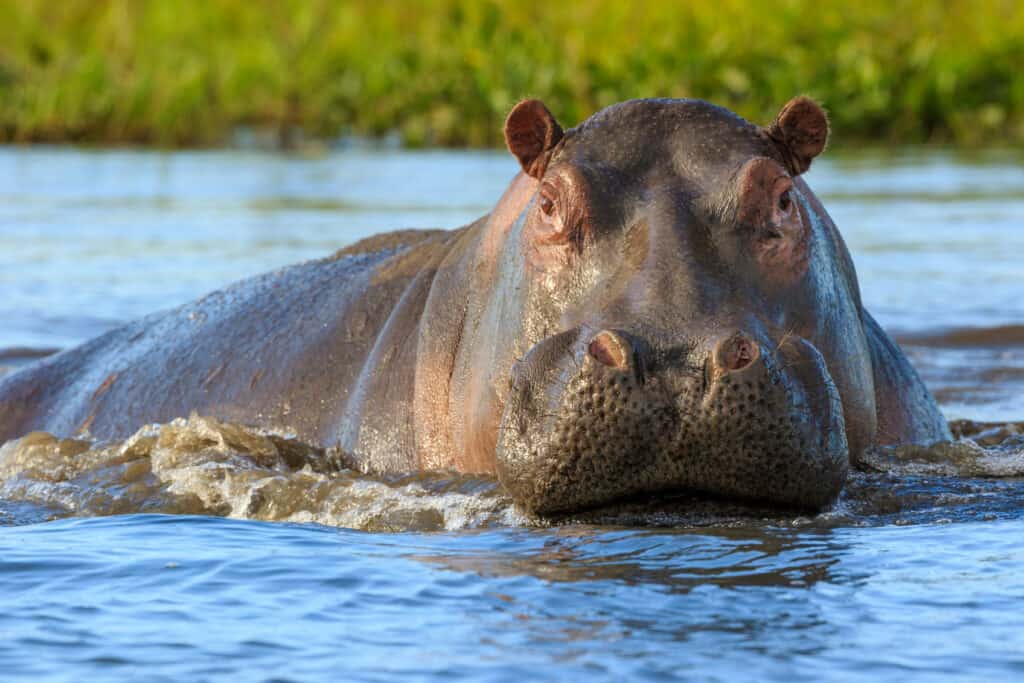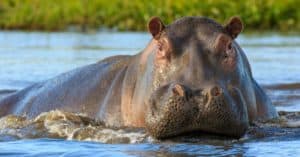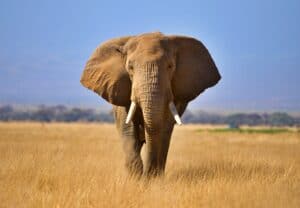As one of the largest living semi-aquatic mammals, hippopotamuses are fascinating creatures. Their name is derived from Greek, meaning “river horse,” describing their love for aquatic habitats. Despite their appearance, and to the surprise of many, hippopotamuses and whales are closely related through a common ancestor that existed roughly 54 million years ago. Hippopotamuses were originally common throughout Europe and Asia but are now only found in Africa. These large animals enjoy spending their time in grasslands where they can feed abundantly as herbivores.
Hippopotamuses expectedly eat a lot to maintain their size, but despite these animals’ menacing looks, they are not aggressive unless provoked. Even then, there are extinct hippo species that looked more fearsome and were believed to be even more aggressive, and one such species is the Desmostylus- a prehistoric hippo with fangs that once roamed the earth. Please keep reading to learn more about this ancient hippo and what the earth was like when it existed.
How To Identify the Desmostylus

Demostylus weighed as much as 3,000 lbs and were as long as nine feet but only reached a height of around 3.5 feet.
©Dmitry Bogdanov / CC BY 3.0 – License
These extinct herbivores lived from the Late Oligocene to the Miocene epoch. The Desmostylus belonged to the family Desmostylidae and has no living descendants, making it hard to trace its history fully or learn its habits. These hippo-like creatures weighed as much as 3,000 lbs and were as long as nine feet but only reached a height of around 3.5 feet. They also had short tails and four incredibly strong legs with hooves at the end. Since the Desmostylus was primarily a marine mammal, it had characteristics that made it possible to live most of its life in water. For example, the lower forelegs’ bones were united to form a stiff appendage. This might have made it difficult to walk on land, but swimming would have been much easier.
One of the most distinctive features of this animal was its fang-like teeth. The creature’s two extended jaws had tusks that faced forward and acted as the animal’s elongated canines and incisors. Many experts still wonder why these animals had these fang-like teeth, considering that they were herbivores and had no reason to kill and eat other animals. However, some other experts believe these teeth were used to protect against harm from other predatory animals. These fang-like teeth were similar to those owned by another prehistoric animal, the Gomphotherium, a prehistoric elephant-like animal that lived during the Neogene period.
Desmostylus Distribution and Habitat

Demostylus is believed to have existed for over 20 million years.
©Sandy__R from Scotland, UK / CC BY 2.0 – License
The Desmostylus existed between the Late Oligocene period through the Late Miocene period, between 28.4 and 7.250 million years ago. The creature is believed to have existed for over 20 million years, and based on where the fossils were found, it is believed to have inhabited various locations, such as several parts of Japan in Asia and the Pacific Rim in North America. Although somehow closely related to modern hippos, experts believe that there were still so many things that distinguished these animals asides from appearance.
Even though these ancient hippo-looking creatures are believed to have been semi-aquatic, there is evidence that they spent most of their time in the water and could dive really deep, but not past 100 feet. According to experts, the primary reasons these animals spent any time on land were to rest, mate, or forage for food. Despite looking like modern hippos, the Desmostylus’ lifestyle would have been more akin to that of sea lions. Desmostylus apparently spent most of its life in the shallow waters of coastal regions, as evidenced by how its bones were formed. However, some findings imply that they may have also resided in freshwater and estuarine habitats.
Even though the exact cause of the animal’s extinction is unknown, experts think that changes to the Desmostylus’ habitat provide clues. Desmostylus began its existence as a marine animal, spending most of its time near coastlines. It is believed that because the Miocene era brought about the existence of new mammals, the Desmostylus was forced into freshwater environments. This newfound rivalry and change in habitat most likely contributed to their extinction.
What Did the Desmostylus Eat?

Because of their specialized teeth, it is thought that Demostylus could eat deeply rooted plants.
©Ryan M. Bolton/Shutterstock.com
Desmostylus were believed to be herbivores, just like present-day hippos, but the exact plants that these animals consumed remain unknown. These huge mammals are believed to have fed upon soft aquatic plants that could have been found around their habitats. Also, because of their specialized teeth, it is thought that they could also eat deeply rooted plants. Additionally, the teeth in the anterior lower jaw evolved into tusks and formed a shovel-like configuration. Two more tusk-like teeth emerged from the top jaw, and the name Desmostylus, which means “chain pillar,” was given to it because of the cylindrical configuration of the rear teeth.
There is little known about the animals, particularly predators, that lived at the same time as the Desmostylus. Because these large mammals were almost entirely defenseless minus their fang-like-looking teeth, it is believed that many other predators that shared habitat with them could have easily preyed on them.
Desmostylus vs. Modern Hippopotamus

Despite having incredibly long and razor-sharp teeth, hippopotamuses are herbivorous animals, like the Desmostylus.
©Radek Borovka/Shutterstock.com
Despite the Desmostylus being more like a sea lion, this animal still shares many similarities with modern hippos. The primary similarity between these two animals is their appearance. Like modern hippos, the Desmostylus had a large body and powerful legs that helped it adapt to life on land and in water. Like the Desmostylus, modern hippos can also live on land and water. The hippopotamus spends the day wading through the marshy waters and the night grazing on the tiny islands. The primary reason for these animals to be on land include mating, resting, and feeding.
Another thing these two animals have in common is their choice of food. Both herbivores, these animals spend a lot of time eating to maintain their weight (a hippo has an average size of 3,000 pounds), and they tend to find more food around their preferred habitats. Despite having incredibly long and razor-sharp teeth, hippopotamuses are herbivorous animals, like the Desmostylus.
Up Next:
What was the Largest Prehistoric Hippo?
Hippopotamus Teeth: Everything You Need to Know
Discover the Ancient Terrible Ape That Weighed Over 100lbs
The photo featured at the top of this post is ©
Sources
- , Available here: https://ucmp.berkeley.edu/mammal/mesaxonia/desmostylia.html
- , Available here: https://www.sciencedirect.com/science/article/abs/pii/S0031018217301372
- , Available here: https://www.tandfonline.com/doi/abs/10.1080/02724634.2016.1078344
Thank you for reading! Have some feedback for us? Contact the AZ Animals editorial team.






